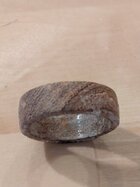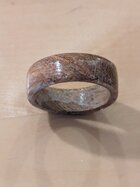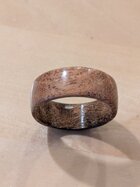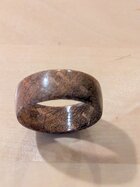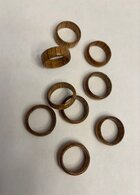Hi, I started turning rings a bit ago. Part of, or perhaps most of the process is in figuring out how I should finish them. I turned both test cases out of a piece of mesquite I had in the trash ( I love tiny projects ). As a quick aside, I'll mention that I turned another ring out of bacote and it looked pretty sweet, but that wood, I guess, is quite brittle and it didn't last too long.
The initial ring I turned I put on the same CA finish process that I use on pens. I use GluBoost CA Glue with matching accelerator. I start with about 4 coats of thin, then move to medium for about 8 or 9 coats. I then sand with those little square things that go up to 1 million grit. However, I didn't do that on these tests because I didn't really care how it looked so much as if it can survive.
My premise is that if I can wear a ring and it survives than it will survive anyone because I am an absolute brute. If I was wearing a tux ( an absurd premise I know ) and I got an urge I'd go right into the shop wearing it cuz I'm just that oblivious. So this is the ultimate ring finish test the way I see it.
So I wore this ring for about 4 days. During this time I did one day of yard work and that's about it. ( not very brutish admittedly, but it was plenty ). At the end of that weekend the ring looked like it does in these pics ( the first two ). Basically ruined.
I had heard about a "new" kind of CA that was mildly flexible, i.e. not as brittle, so I ordered some. In my research I read that it may even be a bit stronger than regular CA. I got the Mercury M20FT Flex ( thin ) and the matching accelerator. I didn't want to get both thin and medium cuz I"m cheap and didn't know if it would work.
I turned a new ring and put on 4 or 5 coats of the Flex CA thin. I don't remember why I stopped there, I guess it looked like it was building up well. Or perhaps I superglued my self to the drill press by accident. I don't remember.
I then donned the ring and have been wearing it for > 1 month. Still wearing it. And it has been through a LOT. As you can see from the pictures ( the second two ), not only is still fully intact, it still retains most of it's shine.
This strikes me as such a significant improvement that I feel compelled to write up this review. It is huge. I don't know what the down side of flex is, it's the same price as any name brand CA. And if you are using it for finish, given it requires so few coats it ends up being much cheaper. Pretty great stuff.
One question is, does one need a top coat finish. My initial thought was that you do because you may and most likely will get it wet. But then I thought about the fact that wooden bowls last for years getting soup slopped in them and then washed clean over and over. So perhaps it's not necessary. It's possible that, given the fairly thin nature of a ring, that the repeated exposure will weaken it and cause the ring to break. I don't know. That will be the next test.
The initial ring I turned I put on the same CA finish process that I use on pens. I use GluBoost CA Glue with matching accelerator. I start with about 4 coats of thin, then move to medium for about 8 or 9 coats. I then sand with those little square things that go up to 1 million grit. However, I didn't do that on these tests because I didn't really care how it looked so much as if it can survive.
My premise is that if I can wear a ring and it survives than it will survive anyone because I am an absolute brute. If I was wearing a tux ( an absurd premise I know ) and I got an urge I'd go right into the shop wearing it cuz I'm just that oblivious. So this is the ultimate ring finish test the way I see it.
So I wore this ring for about 4 days. During this time I did one day of yard work and that's about it. ( not very brutish admittedly, but it was plenty ). At the end of that weekend the ring looked like it does in these pics ( the first two ). Basically ruined.
I had heard about a "new" kind of CA that was mildly flexible, i.e. not as brittle, so I ordered some. In my research I read that it may even be a bit stronger than regular CA. I got the Mercury M20FT Flex ( thin ) and the matching accelerator. I didn't want to get both thin and medium cuz I"m cheap and didn't know if it would work.
I turned a new ring and put on 4 or 5 coats of the Flex CA thin. I don't remember why I stopped there, I guess it looked like it was building up well. Or perhaps I superglued my self to the drill press by accident. I don't remember.
I then donned the ring and have been wearing it for > 1 month. Still wearing it. And it has been through a LOT. As you can see from the pictures ( the second two ), not only is still fully intact, it still retains most of it's shine.
This strikes me as such a significant improvement that I feel compelled to write up this review. It is huge. I don't know what the down side of flex is, it's the same price as any name brand CA. And if you are using it for finish, given it requires so few coats it ends up being much cheaper. Pretty great stuff.
One question is, does one need a top coat finish. My initial thought was that you do because you may and most likely will get it wet. But then I thought about the fact that wooden bowls last for years getting soup slopped in them and then washed clean over and over. So perhaps it's not necessary. It's possible that, given the fairly thin nature of a ring, that the repeated exposure will weaken it and cause the ring to break. I don't know. That will be the next test.

